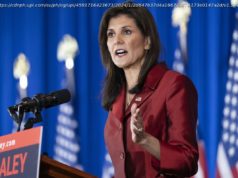Fire, fury, love. Between the two of them, President Donald Trump and North Korea’s Kim Jong Un have created a mythology about the U. S.…
Fire, fury, love.
Between the two of them, President Donald Trump and North Korea’s Kim Jong Un have created a mythology about the U. S.-North Korean relationship that could gain another chapter when they meet in Hanoi this week for their second summit.
According to that mythology, the U. S. came to the brink of war (says Trump) with a rising nuclear power able to rain destruction on U. S. soil (says Kim). Talk (by Kim and Trump) of nuclear buttons on desks evolved into some kind of “love” (says Trump) and now the two are on the road to a nuclear-free and even prosperous North. Trump tweeted cheerily in anticipation of the summit: “North Korea will become a different kind of Rocket – an Economic one!”
The reality is more prosaic, though still historic: Two hostile nations — one wealthy, one impoverished, both bristling with weapons — are talking at the highest level.
Trump came back from the first summit last June claiming the marquee achievement of getting North Korea on board with “total denuclearization” and maintaining that process was immediately underway.
But Kim has never renounced nuclear weapons development. The Pentagon last month called the North an “extraordinary threat.” Dan Coats, Trump’s national intelligence director, earned the president’s ire when he told senators the North is taking actions inconsistent with denuclearization and that the North considers its nuclear arsenal critical to its survival.
The next chapters are yet to be written by Trump and Kim. Their story so far has been marked by overwrought accounts of the perils at hand and over-the-top pronouncements of progress.
A look at myths and reality on their past rhetoric:
THE PERILS
MYTH: The U. S. and North Korea were about to go to war when Trump came to office.
—”When I came in, North Korea was — it looks like it was going to war. You know that. It was going to happen, bad things.” — Trump at rally in El Paso, Texas, Feb. 11.
—”If I had not been elected president of the United States, we would right now, in my opinion, be in a major war with North Korea with potentially millions of people killed.” — Trump in State of the Union speech, Feb. 5.
—Previous presidents left Trump “with a major war ready to start.” — Trump tweet Jan. 24.
REALITY: Trump cites no evidence to support what he sometimes states as a fact and other times as his opinion. The idea that war was close rings false through the foreign policy establishment and is disputed by people who served under President Barack Obama, such as Ben Rhodes, who was deputy national security adviser, and John Brennan, Obama’s CIA chief.
To the extent that belligerence is a harbinger of war, the risk increased under Trump.
Agitated by North Korea’s provocative nuclear and missile tests in 2017, Trump engaged with Kim in an escalating war of words as each man bragged about the nuclear buttons within reach. Insults flew about the U. S. “dotard” and the North’s “rocket man.”
Trump departed from recent predecessors in openly warning of war with the North, telling reporters in August 2017 that if the North Koreans continued to make threats, “They will be met with fire and fury like the world has never seen.” And he told the United Nations that if the U. S. is “forced to defend itself or its allies, we will have no choice but to totally destroy North Korea. Rocket Man is on a suicide mission for himself and for his regime.”
North Korea’s aggressive testing and the ferocious rhetoric of the two leaders that year triggered war fears among South Koreans, who over the decades had grown stoic in the face of threats from their bellicose neighbor.
Obama is known to have pointed to North Korea as a vexing problem in a postelection meeting with Trump, not necessarily as one about to erupt into warfare.
MYTH: North Korea can mount a nuclear attack striking anywhere in the U. S.
—”It’s not a mere threat but a reality that I have a nuclear button on the desk in my office. All of the mainland United States is within the range of our nuclear strike.” — Kim, Jan. 1,2018.
—North Korea no longer needs to test intermediate and intercontinental missiles, or to conduct nuclear tests, because “the work for mounting nuclear warheads on ballistic rockets was finished” and “whole processes of developing nuclear weapons were carried out in a scientific way.






